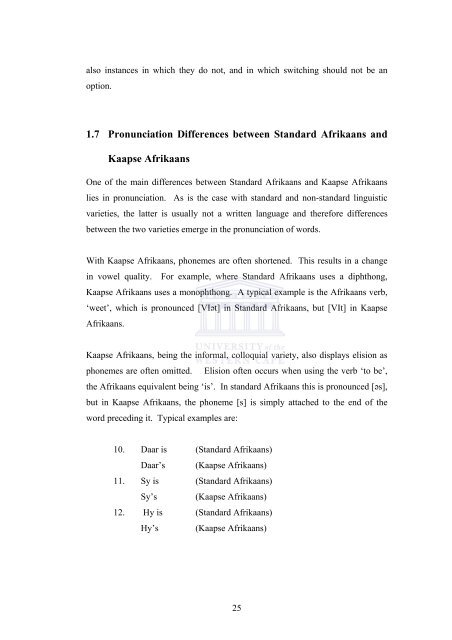grammatical constraints and motivations for - University of the ...
grammatical constraints and motivations for - University of the ...
grammatical constraints and motivations for - University of the ...
Create successful ePaper yourself
Turn your PDF publications into a flip-book with our unique Google optimized e-Paper software.
also instances in which <strong>the</strong>y do not, <strong>and</strong> in which switching should not be an<br />
option.<br />
1.7 Pronunciation Differences between St<strong>and</strong>ard Afrikaans <strong>and</strong><br />
Kaapse Afrikaans<br />
One <strong>of</strong> <strong>the</strong> main differences between St<strong>and</strong>ard Afrikaans <strong>and</strong> Kaapse Afrikaans<br />
lies in pronunciation. As is <strong>the</strong> case with st<strong>and</strong>ard <strong>and</strong> non-st<strong>and</strong>ard linguistic<br />
varieties, <strong>the</strong> latter is usually not a written language <strong>and</strong> <strong>the</strong>re<strong>for</strong>e differences<br />
between <strong>the</strong> two varieties emerge in <strong>the</strong> pronunciation <strong>of</strong> words.<br />
With Kaapse Afrikaans, phonemes are <strong>of</strong>ten shortened. This results in a change<br />
in vowel quality. For example, where St<strong>and</strong>ard Afrikaans uses a diphthong,<br />
Kaapse Afrikaans uses a monophthong. A typical example is <strong>the</strong> Afrikaans verb,<br />
‘weet’, which is pronounced [VIət] in St<strong>and</strong>ard Afrikaans, but [VIt] in Kaapse<br />
Afrikaans.<br />
Kaapse Afrikaans, being <strong>the</strong> in<strong>for</strong>mal, colloquial variety, also displays elision as<br />
phonemes are <strong>of</strong>ten omitted. Elision <strong>of</strong>ten occurs when using <strong>the</strong> verb ‘to be’,<br />
<strong>the</strong> Afrikaans equivalent being ‘is’. In st<strong>and</strong>ard Afrikaans this is pronounced [əs],<br />
but in Kaapse Afrikaans, <strong>the</strong> phoneme [s] is simply attached to <strong>the</strong> end <strong>of</strong> <strong>the</strong><br />
word preceding it. Typical examples are:<br />
10. Daar is (St<strong>and</strong>ard Afrikaans)<br />
Daar’s (Kaapse Afrikaans)<br />
11. Sy is (St<strong>and</strong>ard Afrikaans)<br />
Sy’s (Kaapse Afrikaans)<br />
12. Hy is (St<strong>and</strong>ard Afrikaans)<br />
Hy’s (Kaapse Afrikaans)<br />
25
















